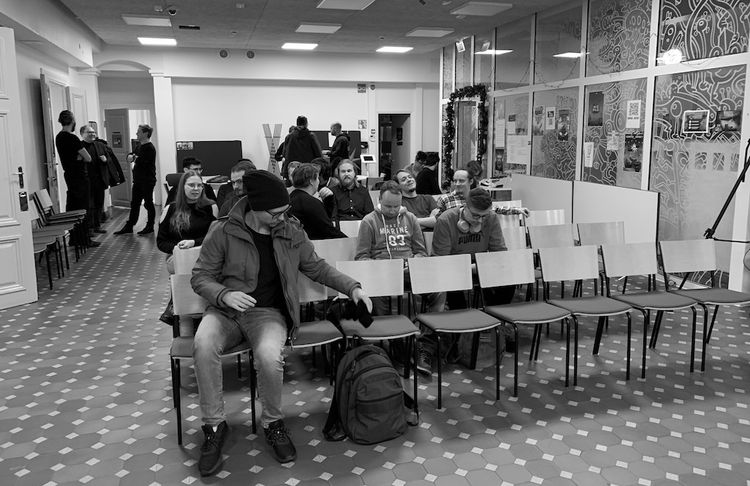Pre-mortems, and why your game will fail

I’ve had so many failures in my gaming career. Some of the failures happened quickly, with the inability to secure capital, failure to have the right technology to build the game I wanted. But mostly, the real loss has come from not realizing the inevitable crash.
Many projects never leave the drawing board because the game designer believes that they can foresee the failure. They’ve been there before, and they can live in the future and see the roads that lead to failure by muscle memory.
As Kristian Segerstråle said on a recent discussion panel: “[Gaming is the] business of making art, culture and experiences. It never stands still. It is not a distribution business [like Amazon,] where people want boxes at home as quickly as possible from a delivery service. It’s never a [static] thing. [Gaming] experiences always move forward.”
Gaming is so different from any other media. People need to keep up or face failure. On the Invest Like The Best podcast, essayist Matthew Ball said that “when it comes to why Hollywood misunderstands Gaming today, comes from the fact that most of the [Hollywood] CEOs, had their primary exposure to Gaming in the PlayStation 2 era. They remember their kids, when they were 14, playing Lara Croft, an overly pixelated woman shooting people. And the degree to which [Gaming] has evolved over the past 15 years. It’s just hard to encapsulate in a single line, but it’s unlike that we’ve seen in any other category.”
To keep up, people need to work together. As Kristian Segerstråle said: “Gaming is an alchemy of art, design, technology, culture, and business knowledge. More people are required to share their views, discuss, [give] feedback, and find that intersection of product and insight where all of those things fit.”
To keep up and launch a game in six or twelve months, a game that’s fresh and relevant for players requires more than just seeing into the future. The innovations involved mixing and matching gameplay, getting the core gameplay right, and understanding the audience.
Making decisions
Once the concept seems solid, decisions need to be made. I’ve talked about the Magical Pairs in Gaming. The pair consists of two highly capable game developers, who lead the effort. They craft the shape, the form, and the final outline for the game. They’d continuously work together to revise and iterate the concept. They are the vision holders, and they make the decisions.
But how do they make the right decisions? There is a massive opportunity cost to working on a project that could fail. In Gaming, development costs and time allocations have grown immensely. Projects last six to twelve months and cost millions of dollars to complete.
The pair can’t spot everything. I’ve noticed that one reason for failure is that too many people on the game teams are reluctant to speak up about their reservations during the all-important planning phase. By making it safe for dissenters who are knowledgeable about the undertaking and worried about its weaknesses to speak up, you can improve a project’s chances of success.
Pre-mortems
A strong solution that is gaining popularity in game development is the pre-mortem. It’s a solution for pre-emptively coming up with all the possible failure situations of a project. Research conducted in 1989 by Deborah J. Mitchell, of the Wharton School; Jay Russo, of Cornell; and Nancy Pennington, of the University of Colorado, found that prospective hindsight—imagining that an event has already occurred—increases the ability to correctly identify reasons for future outcomes by 30%.
A pre-mortem is the opposite of a post-mortem, but similar in many ways. A post-mortem in a medical setting allows health professionals and the family to learn what caused a patient’s death. Everyone benefits except, of course, the patient. A pre-mortem should happen at the beginning of a game project to improve the game project to have the most significant impact.
To run a pre-mortem, here’s what you do.
Set up a meeting for your game team In a pre-mortem, team members assume that the project they are planning has just failed—as so many do—and then generate plausible reasons for its demise. Those with reservations may speak freely at the outset so that the project can be improved rather than autopsied.
Set goals for the meeting. The team members’ task is to generate plausible reasons for the project’s failure. The leader starts the exercise by informing everyone that the project has failed spectacularly. Over the next few minutes, those in the room independently write down every reason they can think of for the failure.
Take turns Next, the leader asks each team member to read one reason from his or her list; everyone states a different reason until all have been recorded. After the session is over, the project manager reviews the list, looking for ways to strengthen the plan.
Bring in people from outside. Often the team is very trenched with the project and doesn’t see issues revealed by outsiders, who are not as invested in the project.
Give autonomy to team leads. All the failure situations should be discussed openly and comments heard by everyone involved. But, as the project moves forward, it’s essential to let the team leads work on the raised issues without pressure. Pre-mortems should be repeated during the early phases of the project so that open questions can be aired and possible failure situations don’t get “swept under the rug.”
Pixar’s Braintrust
Pixar has a great analog for a pre-mortem, the Braintrust.
3D animations studio Pixar started doing so-called Braintrust meetings in the 1990s, to pre-emptively figure out issues with their productions. It had a similar connotation to the pre-mortem, where they’ve to bring in twenty people into a meeting room, hear out the director, producer, and other production team members explain the status and storyline of a movie.
In Pixar co-founder Ed Catmull’s book, Creativity Inc., he describes the BrainTrust meetings as a place of discovery.
Catmull wrote of the reasoning for the BrainTrust:
- “How do you get a director to address a problem he or she cannot see?”
- “A mystifying plot twist or a less-than-credible change of heart in our main character is often caused by subtle, underlying issues elsewhere in the story.”
- “[The BrainTrust is a] hallmark of a healthy creative culture is that its people feel free to share ideas, opinions, and criticisms.”
- “The Braintrust meets every few months or so to assess each movie we’re making. Its premise is simple: Put smart, passionate people in a room together, charge them with identifying and solving problems, and encourage them to be candid.”
- “The Braintrust has no authority. The director does not have to follow any of the specific suggestions. After a Braintrust meeting, it is up to him or her to figure out how to address the feedback.”
The BrainTrust will point to an issue and then allow the director to figure out the problem independently. Most importantly, of course, is that the film is under review and not the filmmaker.
Why is BrainTrust useful? Again, now for a product owner / Game Lead: “How do you get a director to address a problem he or she cannot see?”
As a company grows, the schedule (that is, the need for product) drives the output, not the strength of the ideas at the front end.
One important aspect is to develop full candor amongst the team: In a 1–1 environment, we are usually open. But when we are in a group, our animal instincts start to kick in, and fear takes over. We want to secure a reasonable opinion that everyone likes and not be the rebel in the room.
As Catmull has confirmed, “You are not your idea, and if you identify too closely with your ideas, you will take offense when challenged. Candor could not be more crucial to our creative process. Why? Because early on, all of our movies suck. That’s a blunt assessment, I know, but I choose that phrasing because saying it in a softer way fails to convey how bad the first versions really are.”
How to apply a BrainTrust into Gaming? To start your Brain Trust, Catmull recommends choosing people that make you think smarter, putting lots of solutions on the table, and finding people who will level with you.
Catmull explains that “The Braintrust is made up of people with a deep understanding of storytelling, who usually have been through the process themselves.”
Start with game designers and product people, then carefully expand. “the Braintrust evolved from a tight, well-defined group working on a single film into a larger, more fluid group. Over the years, its ranks have grown to include a variety of people–directors, writers, and heads of story–whose only requirement is that they display a knack for storytelling”.
Why can it be hard to uphold a BrainTrust? You need someone owning the BrainTrust: “While I attend and participate in almost all Braintrust meetings, I see my primary role as making sure that the compact upon which the meetings are based is protected and upheld.”
Unfortunately, “you can’t totally eliminate the blocks to candor. The fear of saying something stupid and looking bad, of offending someone or being intimidated, of retaliating or being retaliated against–they all have a way of reasserting themselves. And when they do, you must address them squarely.”
Pre-mortem user’s guide
I’ve created a step-by-step guide for a game developer pre-mortem. You can get you copy of “How To Run A Pre-Mortem Meeting” from here:





